Abstract
This study used impedance spectroscopy measurements to extract the electrical properties of phytoplankton cells in suspension. Experimental measurements were acquired, and the single-shell model was applied to extract the specific membrane capacitance, cytoplasm permittivity, and conductivity of assumingly spherical cells in suspension utilizing Maxwell’s mixture theory of a controlled volume fraction of cells. The impedance of suspensions of algae was measured at different frequencies ranging from 3 kHz to 10 MHz and impedance values were compared to investigate differences between two types of cells by characterizing their change in cytoplasm permittivity and specific membrane capacitance. Differentiation between healthy control and nitrogen-depleted cultured algae was attempted. The extracted specific membrane capacitances of Chlamydomonas and Selenastrum were 15.5 ± 3.6 and 40.6 ± 12.6 mF m− 2 respectively. Successful differentiation based on the specific membrane capacitance of different algae species was achieved. However, no significant difference was noticed between nitrogen-abundant and nitrogen-depleted cultures.




Similar content being viewed by others
References
Abt V, Gringel F, Han A, Neubauer P, Birkholz M (2020) Separation, characterization, and handling of microalgae by dielectrophoresis. Microorganisms 9:540
Andersen RA (ed.) (2005) Algal culturing techniques. Elsevier, Amsterdam
Das D, Kamil FA, Biswas K, Das S (2014) Evaluation of single cell electrical parameters from bioimpedance of a cell suspension. RSC Adv 4:18178–18185
Deng YL, Juang CJS JY (2013) Separation of microalgae with different lipid contents by dielectrophoresis. Bioresour Technol 135:137–141
Domozych DS, Ciancia M, Fangel JU, Mikkelsen MD, Ulvskov P, Willats WGT (2012) The cell walls of green algae: a journey through evolution and diversity. Front Plant Sci 3:82
Donk EV, Lürling M, Hessen D, Lokhorst G (1997) Altered cell wall morphology in nutrient-deficient phytoplankton and its impact on grazers. Limnol Oceanogr 42:357–364
Foster K, Schwan H (1989) Dielectric properties of tissues and biological materials: a critical review. CRC Biomed Eng 17:25–104
Graham L, Wilcox L (2000) Algae. Prentice-Hall. Upper Saddle River
Hadady H, Wong JJ, Hiibel SR, Redelman D, Geiger EJ (2014) High frequency dielectrophoretic response of microalgae over time. Electrophoresis 35:3533–3540
Jang LS, Wang MH (2007) Microfluidic device for cell capture and impedance measurement. Biomed Microdevices 9:737–743
Kumar RTK, Kanchustambham P, Kinnamon D, Prasad S (2017) 2D dielectrophoretic signature of Coscinodiscus wailesii algae in non-uniform electric fields. Algal Res 27:109–114
Lasia A (2014) Electrochemical impedance spectroscopy and its applications. Springer, New York
Lindsey R, Scott M (2010) What are Phytoplankton?. https://earthobservatory.nasa.gov/features/Phytoplankton
Mata TM, Martins AA, Caetano NS (2010) Microalgae for biodiesel production and other applications: a review. Renew Sust Energy Rev 14:217–232
Maxwell J (1954) Treatise on Electricity and Magnetism. 2 vols. Dover, New York
Morgan H, Green NG (1997) Dielectrophoretic manipulation of rod-shaped viral particles. J Electrost 42:279–293
Morgan H, Sun T, Holmes D, Gawad S, Green NG (2007) Single cell dielectric spectroscopy. J Phys D 40:61–70
Petchakup C, Li KHH, Hou HW (2017) Advances in single cell impedance cytometry for biomedical applications. Micromachines 8:87
Sancho M, Martínez G, Martín C (2003) Accurate dielectric modelling of shelled particles and cells. J Electrost 57:143–156
Searchinger T, Heimlich R, Houghton RA, Dong F, Elobeid A, Fabiosa J, Tokgoz S, Hayes D, Yu TH (2008) Use of U.S. croplands for biofuels increases greenhouse gases through emissions from land-use change. Science 319:1238–1240
Siebman C, Velev O, Slaveykova V (2017) Alternating current-dielectrophoresis collection and chaining of phytoplankton on chip: Comparison of individual species and artificial communities. Biosensors 7:4–4
Sun T, Morgan H (2010) Single-cell microfluidic impedance cytometry: a review. Mircrofluid Nanofluid 8:423–443
Wang B, Li Y, Wu N, Lan CQ (2008) CO2 biomitigation using microalgae. Appl Microbiol Biotechnol 79:707–718
Wanichapichart P, Bunthawin S, Kaewpaiboon A, Kanchanapoom K (2001) Determination of cell dielectric properties using dielectrophoretic technique. ScienceAsia 28:113–119
Weaver JC, Chizmadzhev YA (1996) Theory of electroporation: A review. Bioelectrochem Bioenerg 41:135–160
Zabara MA, Ulgut B (2020) Electrochemical Impedance Spectroscopy based voltage modeling of lithium thionyl chloride (Li∖SOCL2) primary battery at arbitrary discharge. Electrochim Acta 334:135584–135584
Zhu L (2015) Biorefinery as a promising approach to promote microalgae industry: An innovative framework. Renew Sust Energ Rev 41:1376–1384
Funding
The authors would like to acknowledge the support from National Science Foundation under grant No. 1550509 “Isomotive dielectrophoresis for enhanced analyses of cell subpopulations.”
Author information
Authors and Affiliations
Contributions
S. J. W. and S. P. H. obtained funding for the project. S. P. H. provided cells from various cultures for the experiments.
Corresponding author
Ethics declarations
Conflict of interest
The authors declare that they have no conflict of interest.
Additional information
Publisher’s note
Springer Nature remains neutral with regard to jurisdictional claims in published maps and institutional affiliations.
M. R. J and M. Z. R contributed equally to this work.
Rights and permissions
About this article
Cite this article
Jett, M.R., Rashed, M.Z., Hendricks, S.P. et al. Electrical characterization of phytoplankton suspensions using impedance spectroscopy. J Appl Phycol 33, 1643–1650 (2021). https://doi.org/10.1007/s10811-020-02363-2
Received:
Revised:
Accepted:
Published:
Issue Date:
DOI: https://doi.org/10.1007/s10811-020-02363-2




